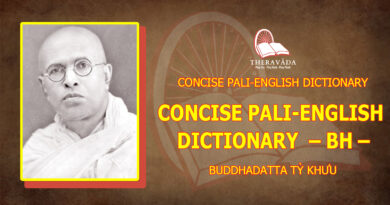NO INNER CORE – ANATTA: ANALYSIS OF THE DISCOURSE ON THE CHARACTERISTIC OF NO-SOUL
NO INNER CORE – ANATTA: ANALYSIS OF THE DISCOURSE ON THE CHARACTERISTIC OF NO-SOUL
Let us now study in more detail the Sutra which teaches the doctrine of anatta, known as the Anattalakkhana Sutta, “The Discourse on the Characteristic of No-Soul.” This was the second sermon of the Buddha.
At the end of the first sermon, the Venerable Kondanna became a Sotapanna (a person at the first stage of enlightenment) and then, according to the Commentaries, for example, the Commentary on Vinaya, the other four disciples became Sotapannas, one on each of the four following days. On the first day after the full-moon day in July, the monk Vappa became a Sotapanna; on the second day, Bhaddiya; on the third day, Mahanama; and on the fourth day, Assaji. After they became Sotapannas, they all asked Buddha for ordination. Buddha ordained each of them by calling to them, “Come monks.” On the fifth day after the full-moon day, the Buddha assembled them and preached to them this discourse on no-soul.
This discourse’ is even shorter than the first sermon on the Four Noble Truths. It was delivered at the Deer Park at Benares. Buddha called the disciples by saying, “Monks,” and they replied, “Venerable Sir” and then the Buddha started.
We can divide the Sutta into five parts. In the first part, Buddha says that the five ag,regates are not atta, not self or soul. In the second section, Buddha asks the monks if the five aggregates are permanent or impermanent, pleasurable or painful, and then He arrives at the conclusion that the nature of the five aggregates is anatta. In the third section, Buddha teaches that the five aggregates should not be taken as a soul or self or as belonging to one-self. In the fourth section, Buddha explains briefly the progress of Vipassana meditation.
The last section records that all five monks had attained the stage of Arahant. By the end of the Sutta, all five monks became Arahants which is the highest stage of enlightenment.
Buddha says, “Bhikkhus, form is anatta, (form is not soul or self. Were form soul, then this form would not lead to affliction, and one could have it of form: ‘Let my form be thus; let my form be not thus.’ And since form is not soul, so it leads to affliction, and none can have it of form: ‘Let my form be thus; let my form be not thus.”‘ Here the Pali word rupa is translated as form. The word forms here used in the sense of material properties or just matter.
The reader may recall that the first of the five aggregates is form or corporeality But form cannot be atta because it is subject to affliction. Atta (self or soul) must have the meaning which we discussed earlier: that of vasavattana, something which has the power and autonomy to change the nature of things. No one likes pain and affliction in the body, but it cannot be changed. If form were atta, people could abolish pain, disease, and ugliness by merely wishing. But there is no core or director or soul inside or outside of people which has the power to accomplish such actions.
Buddha considered the second aggregate and says: “Feeling is not soul. Were feeling soul, then this feeling would not lead to affliction, and one could have it of feeling: ‘Let my feeling be thus; let my feeling be not thus.”‘ Then Buddha takes the third, fourth, and fifth aggregates:
“Perception is not soul… Mental formations are not soul…. Consciousness is not soul. Were consciousness soul, then this consciousness would not lead to affliction, and one could have it of consciousness: ‘Let my consciousness be thus; let my consciousness be not thus.”‘ Consciousness cannot be atta because it is not under our control. Consciousness is unavoidably subject to afflictions – to sorrow, depression, and frustration. We cannot avoid being conscious of ugly sights, sounds, and sensations in the world, although we would like to arrange coming into contact with pleasant sensual objects only.
Likewise, in meditation, we would like to be conscious only of the meditation object, and we would like to achieve stillness of mind and concentration, but this is not easy, and we cannot will it. If consciousness were atta, we could will our consciousness to be still and concentrated, and then we could proceed to the higher states of mind – perhaps it would only take one day to advance to the higher stages of meditation!
But in all cases, consciousness arises completely determined by circumstances and conditions, conditions which are not under our control. Therefore, consciousness cannot be atta. In the second section of the Sutta, Buddha asks the monks some Questions, which they answer. Buddha says: “Bhikkhus, how do you conceive it: Is form permanent or impermanent!” Since they were already sotapannas, they had already seen that the five aggregates are impermanent, suffering, and no-soul, so they answered, “Impermanent, Venerable Sir.” Now Buddha asks, “Is what is impermanent, painful, and subject to change fit to be regarded thus:
‘This is mine. This is I. This is my soul?”‘ They answered, “No, Venerable Sir” Form is impermanent because it disappears. It comes into being and then vanishes. It has a beginning and an end. The monks had already realised by means of Vipassana knowledge that form is impermanent. They had already seen the three marks of impermanence, which are the three phases of existence: arising, continuation, and dissolution.
Another way to state this process is to call it non-existence after having been in existence, in Pali – hutva abhavato. Buddha then proceeds to explain that whatever is impermanent is also painful. The mark of pain (dukkha) is constant oppression by rise and fall, by arising and dissolution. This can be seen during meditation, when yogis take thoughts as objects and look at them closely. They see that the moment a thought is observed as an object, it disappears, and another thought takes its place.
As meditators observe very closely with concentration, they see all objects in the mind arising and disappearing constantly, and this is seen as a kind of oppression by arising and disappearing. Phenomena are called oppressed by rise and fall because nothing is ever at peace; everything is menaced by an endless flux. In this sense, whatever is impermanent is dukkha.
Dukkha means more than just painful. Dukkha also comes from our desire for permanence. Dukkha means diffìcult to bear mentally and physically, and thus we call the impermanence of all phe-nomena dukkha (suffering).
In the third part of Buddha’s Questioning, He asks, “Is that which is impermanent and painful fit to be called ‘mine, I, my self or soul?”” Buddha is here leading the monks to the discovery of anatta. Is something that is disappearing fit to be called atta? No. From anicca (impermanence) to dukkha (suffering, and finally to anatta (no-soul) the monks are led.
Let us review again the processes which hide impermanence, suffering, and no-soul. We, as unenlightened people, fail to see impermanence because we do not see the arising and disappearing of things. We are tricked by continuity, which hides the nature of impermanence. We look at things or at consciousness and see them as continuous.
In order to see impermanence, we must observe closely the arising and disappearing of phenomena. We must penetrate, by means of concentration and insight developed in meditation, through the impression of continuity which acts as a cover of impermanence. Let us think of a ring of fire. Someone has a torch and twirls it to create an impression of a circle of fire. But we know that there is really no ring of fire; it is just the impressions of individual positions of the fire at different places and at different times. But our mind takes the impressions as something continuous; rather, our mind connects the impressions and we deceive ourselves.
If we could take a moving picture of the process and watch it at a slow speed, we would see the individual parts of the sequence of the apparent ring of fire. We would only see light at different places and not a circle. If we cannot pinpoint the components of things in order to see them arising and disappearing, we will continue to see things as whole entities.
Let us note here that impermanence in this context means momentary impermanence. If we drop a cup which breaks, we say that it is impermanent. Or if a person dies, we say that the person is impermanent. These examples of impermanence are easy to see.
But when we use that term in the context of Vipassana meditation, we mean the constant arising and disappearing of phenomena, and this can only be observed during Vipassana meditation. Similarly by dukkha, we do not mean ordinary pain or illness. We mean the constant oppression by arising and disappearing, and this can also be seen only in Vipassana meditation, even in phenomena we call pleasurable.
Please recall that dukkha is concealed by postures; more specifically, there is always dukkha in the body but we conceal that pain by changing postures. That is why we instruct meditators to sit very still while they are meditating. If yogis avoid changing postures often, they will achieve mindfulness and concentration, and they will observe the nature of dukkha directly. Anatta, the no-soul nature of all things, is concealed by compactness. We usually see things as solid and compact. We have to train our minds through Vipassana meditation to look at and analyse that compactness more closely.
Just as a scientist uses a microscope to look at things in a laboratory so yogis must use concentration in Vipassana meditation to penetrate into the unsubstantial, anatta nature of things. We must try to see through the apparently solid mass of mental and physical phenomena.
Regarding material things, we try to anaýze and observe them as earth, water fire, air and other material properties. Regarding mental phenomena, we try to see that, for example, one phenomena is contact, another feeling, and another perception, although these may have been experienced very rapidý as oný one mental event. Both mental and physical phenomena are composed of oný elements and forces, and thus have the nature of being anatta (unsubstantial). That is why we must try to observe everything very slowly in meditation in order to see that phenomena are not held together with a core, an atta.
For example, all mental states and material properties have their own functions. Contact has one function, feeling another, and perception still another. If we see these mental phenomena as one connected whole, we fail to see them as parts with specific functions, and we fail to see them as void of a central core, atta.
These mental states actually have different ways of taking objects and responding to them. Lobha (attachment) has one kind of response; dosa (hatred) another. We must see the individual differences of these mental states. We need to analyse and observe deeply to see that mind and matter have individual functions and responses. On superficial observation and analysis, everything seems to be compact, whole, and substantial. All of us think that a book is very solid, but if we could look at this book under a microscope, it would appear full of holes, with empty spaces, like a sieve.
Vipassana is like using a microscope to see that all things are only elements and forces which are not unified by any kind of core, by any kind of atta. In the third section of the Sutta, Buddha states that: ‘Any kind of form, whether past, future, or presently arisen; whether in oneself or external; whether inferior or superior; whether far or near; must with right understanding be regarded thus:
‘This is not mine; this is not I; this is not my self or soul.”‘ There can be different kinds of form, different kinds of matter, but none of them can be regarded as atta or as having atta. The same is true for feelings, perceptions, mental formations, and consciousness.
Next, Buddha explains to the monks the progress made by a meditator:
“When a noble follower who has heard the truth sees thus, he finds estrangement in form, finds estrangement in feeling, finds estrangement in perceptions… in mental formations… in consciousness.” This means that the meditator becomes weary of form, dispassionate about matter. The meditator realises that the aggregates are impermanent, suffering, and no-soul.
“When he finds estrangement, passion fades out.” Buddha is here describing stages of Vipassana meditation in a very brief form with many stages left, out. The disciple wants to be free from the five aggregates, so this person makes more effort. The meditator then arrives at equanimity about formations. When Buddha uses the phrase “finds estrangement,” He is referring to all of the stages of Vipassana up to the very highest stage. After finding estrangement, passion fades out in one moment, the moment of enlightenment. That is the moment known as Path consciousness when some defilement of the mind are eradicated.
Buddha continues, “With the fading of passion, he is liberated.” This means that the meditator has reached the two or three moments after Path consciousness known as Fruition consciousness.
“When liberated. there is knowledge that he is liberated.” Here the meditator reflects on the Path, on Fruition, on Nibbãna, on defilements destroyed, and on defilements that are remaining.
He understands: ‘Birth is exhausted. The holy life has been lived out. What need to be done is done. Of this there is no more beyond.”‘ Like Buddha when He became enlightened, the meditator says similar words. The discourse ends: “This is what the Blessed One said. The Bhikkhus were glad, and they approved His words. Now during this utterance, the hearts of the Bhikkhus of the group of five were liberated from taints, through clinging no more.” This means that they had become Arahants. By under-standing the doctrine of anatta, they were now free of all fetters, defilements, and impurities. They had reached the highest state of enlightenment. They had realised Nibbana and were free from all rebirth.









